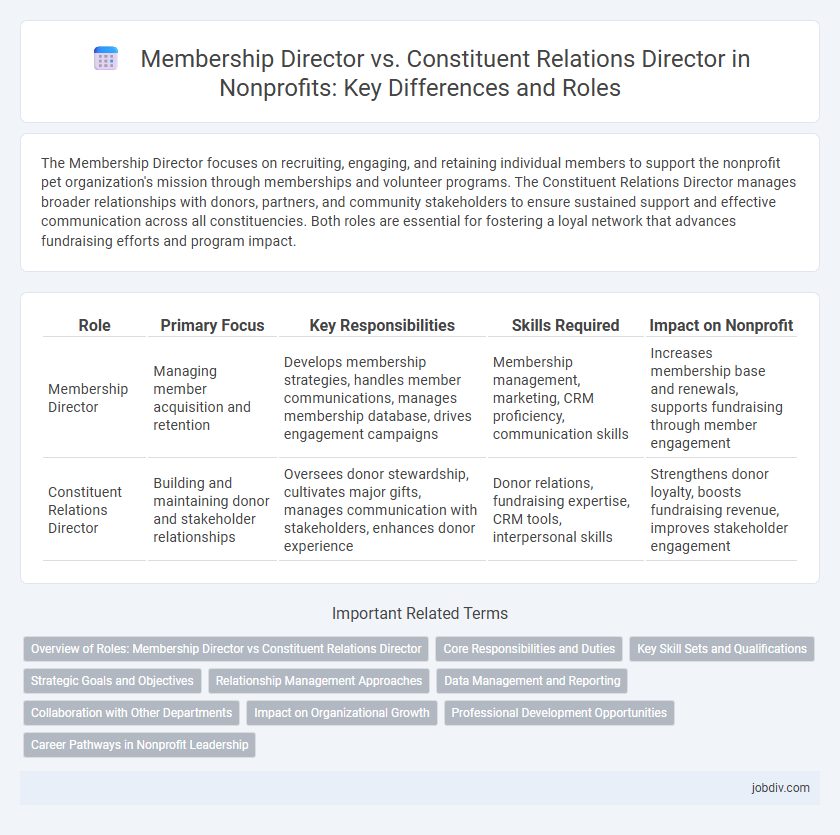The Membership Director focuses on recruiting, engaging, and retaining individual members to support the nonprofit pet organization's mission through memberships and volunteer programs. The Constituent Relations Director manages broader relationships with donors, partners, and community stakeholders to ensure sustained support and effective communication across all constituencies. Both roles are essential for fostering a loyal network that advances fundraising efforts and program impact.
Table of Comparison
| Role | Primary Focus | Key Responsibilities | Skills Required | Impact on Nonprofit |
|---|---|---|---|---|
| Membership Director | Managing member acquisition and retention | Develops membership strategies, handles member communications, manages membership database, drives engagement campaigns | Membership management, marketing, CRM proficiency, communication skills | Increases membership base and renewals, supports fundraising through member engagement |
| Constituent Relations Director | Building and maintaining donor and stakeholder relationships | Oversees donor stewardship, cultivates major gifts, manages communication with stakeholders, enhances donor experience | Donor relations, fundraising expertise, CRM tools, interpersonal skills | Strengthens donor loyalty, boosts fundraising revenue, improves stakeholder engagement |
Overview of Roles: Membership Director vs Constituent Relations Director
The Membership Director focuses on recruiting, retaining, and engaging members to support the nonprofit's mission, overseeing membership growth strategies and benefits programs. The Constituent Relations Director manages broader relationships including donors, volunteers, and community stakeholders, ensuring effective communication and stewardship to enhance long-term support. Both roles require strong relationship management skills, but the Membership Director centers on membership-specific goals, while the Constituent Relations Director drives comprehensive engagement across diverse supporter groups.
Core Responsibilities and Duties
A Membership Director primarily manages member recruitment, engagement, retention, and communication strategies to grow and sustain an active supporter base. The Constituent Relations Director focuses on building and maintaining strong relationships with donors, volunteers, and stakeholders through personalized outreach, stewardship, and impact reporting. Both roles are critical for nonprofit growth, with the Membership Director driving community involvement and the Constituent Relations Director enhancing donor loyalty and investment.
Key Skill Sets and Qualifications
Membership Directors excel in recruitment, retention, and engagement strategies, with strong skills in data analysis, CRM management, and membership growth tactics. Constituent Relations Directors focus on building and maintaining donor and stakeholder relationships, requiring expertise in communication, fundraising, and stakeholder engagement. Both roles demand strategic planning abilities, proficiency in nonprofit software, and a deep understanding of mission-driven outreach.
Strategic Goals and Objectives
The Membership Director focuses on expanding and retaining member base to achieve growth targets, leveraging data-driven strategies to increase engagement and revenue streams. The Constituent Relations Director prioritizes strengthening relationships with donors, volunteers, and stakeholders to enhance loyalty and support for long-term sustainability. Both roles align with strategic goals by ensuring targeted communication and personalized outreach to maximize organizational impact and mission fulfillment.
Relationship Management Approaches
The Membership Director prioritizes member acquisition, retention, and engagement through targeted communication and loyalty programs to build a committed base of supporters. The Constituent Relations Director adopts a holistic approach by managing relationships across all stakeholder categories, including donors, volunteers, and community partners, to foster long-term collaboration and trust. Both roles utilize CRM systems and personalized outreach strategies but differ in scope, with Membership Directors focusing primarily on member-centric initiatives and Constituent Relations Directors overseeing broader stakeholder engagement.
Data Management and Reporting
Membership Directors typically focus on managing member data, tracking engagement metrics, and generating reports to optimize member retention and recruitment strategies within nonprofits. Constituent Relations Directors oversee broader data management systems, integrating donor information, communication preferences, and fundraising outcomes to enhance overall stakeholder engagement and reporting accuracy. Both roles require proficiency in CRM software and data analytics to support strategic decision-making and improve nonprofit impact.
Collaboration with Other Departments
The Membership Director focuses on coordinating with marketing, events, and fundraising teams to drive member engagement and retention, ensuring cohesive outreach strategies. The Constituent Relations Director works closely with communications, development, and program departments to maintain personalized interactions and optimize donor stewardship. Both roles require cross-departmental collaboration to enhance organizational impact and strengthen stakeholder relationships.
Impact on Organizational Growth
The Membership Director drives organizational growth by expanding member base and increasing member engagement, directly influencing revenue streams and community support. The Constituent Relations Director enhances growth through managing donor relationships, volunteer coordination, and stakeholder communication, strengthening long-term donor loyalty and fundraising capacity. Both roles complement each other by balancing member acquisition with sustained constituent engagement to maximize nonprofit impact.
Professional Development Opportunities
Membership Directors benefit from targeted professional development in membership growth strategies, data management, and engagement techniques to effectively expand and retain supporter bases. Constituent Relations Directors gain expertise through training in donor stewardship, relationship management, and communication skills to deepen connections and enhance donor loyalty. Both roles require ongoing development in fundraising trends, CRM technology, and nonprofit leadership to maximize organizational impact.
Career Pathways in Nonprofit Leadership
Membership Directors typically focus on expanding and engaging a nonprofit's supporter base, managing membership programs, and driving fundraising efforts, which cultivates skills in community outreach and donor relations. Constituent Relations Directors oversee the broader spectrum of stakeholder engagement, including major donors, volunteers, and board members, emphasizing strategic communication and long-term relationship management. Career pathways in nonprofit leadership often see professionals transition from Membership Director to Constituent Relations Director roles, leveraging their expertise to influence organizational strategy and enhance mission impact.
Membership Director vs Constituent Relations Director Infographic

 jobdiv.com
jobdiv.com